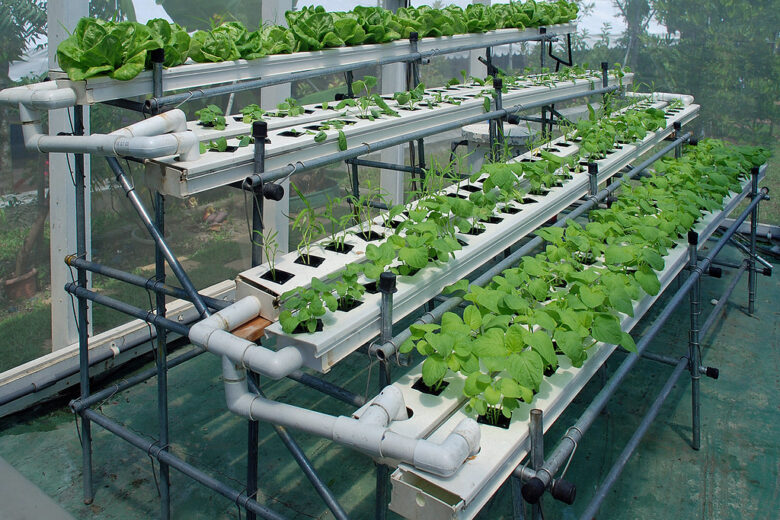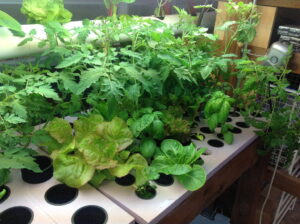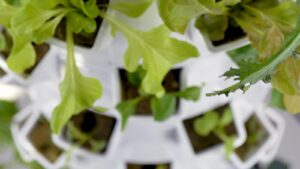Beneath the radiant glow of LED lights, a remarkable revolution is taking root in the world of gardening. Have you ever marveled at the sight of luscious greens and vibrant blooms flourishing without a trace of soil? Welcome to the captivating realm of hydroponics, where plants defy tradition and flourish in water-based wonderlands. But, dear reader, for this whimsical adventure to take flight, the vital ingredient lies in the concoction of hydroponic nutrient solutions – the life force that fuels these aqueous gardens. Fear not, for within the following passages, we shall embark upon a step-by-step journey, unearthing the secrets of crafting the perfect nutrient solution to satiate your plants’ insatiable thirst. So, grab your lab coat and adjust your goggles, as we dive headfirst into the magical world of hydroponic nourishment.
Understanding the Importance of Hydroponic Nutrient Solutions
Hydroponics is not just a trend; it’s a revolutionary way of growing plants without soil. And one of the key factors that make this method successful is the use of nutrient solutions. These solutions are specially formulated to provide essential minerals and nutrients to plants, ensuring their healthy growth and optimal yields.
Creating your own hydroponic nutrient solutions can seem complex, but with this step-by-step guide, you’ll be able to do it like a pro. The first step is to gather the necessary ingredients. You’ll need a range of minerals and nutrients such as nitrogen, phosphorus, potassium, calcium, and magnesium, along with trace elements like iron, zinc, and copper. Thankfully, these can be easily obtained from specialized hydroponic stores or online.
Once you have all the ingredients, it’s time to mix your own nutrient solution. Start by adding the required amount of water to a clean container. Next, carefully measure and add each nutrient component following the recommended dosage provided by the manufacturer. To ensure optimal nutrient availability, experts recommend adding each component one at a time while stirring the solution thoroughly. Be sure to check the pH levels using a pH meter and adjust it to the recommended range, usually between 5.5 and 6.5, by adding pH up or down solutions.
Remember, nutrient solutions are the lifeblood of hydroponic plants, and getting the proportions right is essential for their success. So, keep in mind that different plant species and growth stages may require specific nutrient compositions. Don’t be afraid to experiment and fine-tune your nutrient solutions along the way. With practice and a bit of patience, you’ll be able to tailor nutrient solutions to meet the unique needs of your hydroponic garden, leading to bountiful harvests and healthy plants.
Choosing the Right Ingredients for your Hydroponic Nutrient Solution
When it comes to creating a successful hydroponic nutrient solution, selecting the right ingredients is crucial. These ingredients will provide your plants with the essential nutrients they need to thrive without soil. While the exact composition of your nutrient solution will depend on the type of plants you are growing, there are a few key factors to consider when choosing your ingredients.
1. Macronutrients: Start by determining the macronutrient ratios needed for your plants, which include nitrogen (N), phosphorus (P), and potassium (K). These primary nutrients play a crucial role in promoting healthy growth and development. Leafy greens typically require a higher nitrogen content, while fruiting plants benefit from more phosphorus and potassium.
2. Micronutrients: Don’t forget about the micronutrients! These trace elements are just as important for plant health, even in small quantities. Iron, magnesium, zinc, and copper are just a few examples of micronutrients to consider. A balanced blend of these elements will ensure your plants receive all the necessary nutrients for optimum growth.
3. pH Levels: Another crucial factor to keep in mind when choosing your hydroponic nutrient solution ingredients is the pH level. Different plants thrive in different pH ranges, which can affect nutrient availability and absorption. Use a pH test kit to monitor and adjust the acidity or alkalinity of your solution to match the specific needs of your plants.
Step-by-Step Guide to Mixing and Adjusting Hydroponic Nutrient Solutions
How to Make Hydroponic Nutrient Solutions: A Step-by-Step Guide
Mixing and Adjusting Hydroponic Nutrient Solutions
Creating the perfect nutrient solution for your hydroponic plants is an essential skill every enthusiast should master. With the right blend of nutrients, you can ensure optimal growth, health, and bountiful yields. Here is a step-by-step guide to help you mix and adjust hydroponic nutrient solutions:
1. Gather Your Ingredients: Before you begin mixing your nutrient solution, gather all the necessary ingredients. This typically includes a collection of pH adjusters, individual nutrient salts, and a suitable mixing container. Quality nutrients are vital, so don’t settle for anything less!
2. Calculate the Ideal Ratios: Understanding the specific nutrient requirements of your plants is crucial. Different stages of growth may demand varying ratios of nitrogen, phosphorus, and potassium (NPK) as well as micro and macronutrients. Use reputable resources or consult experts to determine the optimal nutrient ratios for the types of plants you’re growing.
3. Mix and Adjust the Solution: Start by filling your mixing container with water, then add nutrients one at a time, following the calculated ratios. Dissolve each nutrient completely before adding the next. Once all nutrients are added, measure the pH level using a digital pH meter or test strips. Adjust the pH accordingly using pH up or pH down solutions to ensure it falls within the recommended range for your specific plants.
Optimizing Hydroponic Nutrient Delivery: Dosage and pH Recommendations
In order to ensure optimal growth and yields in your hydroponic system, it is crucial to understand the importance of nutrient dosage and pH levels. Achieving the right balance is key to providing your plants with the necessary nutrients they need to thrive. Here, we will provide you with step-by-step guidance on how to prepare and deliver nutrient solutions for your hydroponic setup.
Dosage Recommendations:
- Start by carefully measuring the recommended dosage of each nutrient element based on the specific growth stage of your plants. Refer to the instructions provided by the nutrient manufacturer.
- Dilute the nutrients in the appropriate amount of water, following the indicated ratios. This will help prevent nutrient burn and ensure proper absorption by the plants.
- It is important to monitor your plants closely for any signs of nutrient deficiencies or excesses. Adjust the dosage accordingly to maintain balanced nutrient levels and promote healthy growth.
pH Recommendations:
- Maintaining the correct pH range is crucial for nutrient uptake and plant health. Most hydroponic crops thrive in a slightly acidic pH range between 5.5 and 6.5.
- Regularly check the pH of your nutrient solution using a pH meter or test kit. If the pH deviates from the desired range, make the necessary adjustments using pH up or pH down solutions.
- Remember, pH levels can affect nutrient availability. Adjust the pH of your solution after adding the nutrients to ensure optimal nutrient uptake by your plants.
Taking the time to optimize the delivery of nutrients in your hydroponic system can significantly impact the health and productivity of your plants. By following these dosage and pH recommendations, you can create an ideal environment for your plants to thrive and maximize your hydroponic gardening success. Happy growing!
Essential Tips for Maintaining a Healthy Hydroponic Nutrient Solution
When it comes to hydroponic gardening, maintaining a healthy nutrient solution is crucial for the success of your plants. Here are some essential tips to ensure your solution is in tip-top condition:
1. Regularly monitor pH levels: pH plays a vital role in nutrient uptake by plants. Invest in a reliable pH meter or test kit to keep tabs on acidity or alkalinity levels. Aim for a pH range of 5.5 to 6.5, as this allows optimal nutrient absorption. Adjust your solution accordingly using pH-up or pH-down solutions to maintain the desired pH.
2. Balance nutrient ratios: Different plants have varying nutrient requirements, but ensuring a well-balanced mix is key. Choose a high-quality hydroponic nutrient formula that includes the essential macronutrients – nitrogen, phosphorus, and potassium – as well as secondary macronutrients like calcium and magnesium. You may also want to consider micronutrients like iron, zinc, and copper. Refer to the manufacturer’s instructions or consult a hydroponic expert to determine the appropriate ratios for your chosen plants.
3. Regularly check and adjust nutrient strength: Keeping an eye on the nutrient strength is crucial to avoid over or underfeeding your plants. Use an electrical conductivity (EC) meter to measure the nutrient concentration in your solution. The optimal EC level varies depending on the growth stage of your plants, so be sure to refer to a recommended range for each stage. Adjust the nutrient strength by diluting the solution with water or adding more nutrients as required, always aiming for the optimal EC range.
As you conclude this hydroponic journey, you are now armed with the knowledge and skills to dive into the world of nutrient solutions. By understanding the crucial elements and ratios required for optimal plant growth, you’ve unlocked a world of possibilities. Remember, precision and balance are the keys to success when creating your own hydroponic nutrient solutions.
By harnessing the power of hydroponics, you can cultivate thriving gardens all year round, regardless of space or climate limitations. Embrace the art and science of crafting nutrient solutions tailored to your plants’ needs, and witness the incredible rewards that lie ahead. This step-by-step guide has equipped you with the essentials, empowering you to nourish your vegetation growth with precision and expertise.
As you embark on this hydroponic adventure, let your creativity blossom alongside your plants. Experiment with different ratios and nutrient variations, always keeping a watchful eye on your plants’ health. Remember, in the world of hydroponics, you are both the scientist and artist, continuously learning, adapting, and refining your skills.
With determination, patience, and a willingness to adapt, you can create a hydroponic system that surpasses all expectations. Harness the power of innovation and embrace the possibilities that this method of cultivation offers. This journey may be challenging at times, but the rewards will be bountiful, as you witness the fruits of your labor flourishing in ways you never thought possible.
So, brace yourself to cultivate thriving gardens suspended in air or soil-less mediums. Dive into the endless possibilities of hydroponics, armed with your newfound knowledge in creating the perfect nutrient solutions. Let your creativity sprout and your plants thrive as you embark on a path where science, nature, and your imagination intertwine to redefine what it means to grow.



